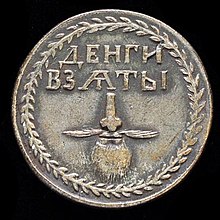Beard tax: Difference between revisions
m →Russia: WP:CHECKWIKI error fixes using AWB |
Rescuing 1 sources and tagging 0 as dead. #IABot (v1.2.6) |
||
| Line 8: | Line 8: | ||
== Russia == |
== Russia == |
||
In 1698,<ref>Fashions in Hair: The first five thousand years, Richard Corson, published 1965 by Peter Owen Ltd, ISBN 0 7206 3283 8 - page 220</ref> Emperor [[Peter I of Russia]] instituted a beard tax to [[Government reform of Peter I|modernize the society of Russia following European models]]. Those who paid the tax were required to carry a "beard token".<ref>{{cite web|url=http://www.america.gov/st/eur-english/2009/November/20091124175845FJreffahcS0.5918848.html#ixzz1hMLiLLv7 |title=Smithsonian Rare Russian Coin Collection Seeks Exhibition Sponsor |publisher=America.gov |date= |accessdate=2011-12-23}}</ref> This was a copper or silver token with a [[Double-headed eagle|Russian Eagle]] on one side and on the other, the lower part of a face with nose, mouth, whiskers, and beard. It was inscribed with two phrases: "the beard tax has been taken" (''lit: "''Money taken") and "the beard is a superfluous burden".<ref>{{citation |last=Florenskiĭ |first=Pavel Aleksandrovich |title=The Pillar and the Ground of Truth |year=1997 |publisher=Princeton University Press |isbn=978-0-691-03243-6 | page = 535 }}</ref> Walter Hawkins published a paper in 1845 illustrating an example of the token from his own collection, and describing the history of the tax in Russia.<ref>Numismatic Chronicle, vol. vii., pp. 153—155, 1845</ref> |
In 1698,<ref>Fashions in Hair: The first five thousand years, Richard Corson, published 1965 by Peter Owen Ltd, ISBN 0 7206 3283 8 - page 220</ref> Emperor [[Peter I of Russia]] instituted a beard tax to [[Government reform of Peter I|modernize the society of Russia following European models]]. Those who paid the tax were required to carry a "beard token".<ref>{{cite web|url=http://www.america.gov/st/eur-english/2009/November/20091124175845FJreffahcS0.5918848.html#ixzz1hMLiLLv7 |title=Smithsonian Rare Russian Coin Collection Seeks Exhibition Sponsor |publisher=America.gov |date= |accessdate=2011-12-23 |deadurl=yes |archiveurl=https://web.archive.org/web/20111013182924/http://www.america.gov/st/eur-english/2009/November/20091124175845FJreffahcS0.5918848.html |archivedate=2011-10-13 |df= }}</ref> This was a copper or silver token with a [[Double-headed eagle|Russian Eagle]] on one side and on the other, the lower part of a face with nose, mouth, whiskers, and beard. It was inscribed with two phrases: "the beard tax has been taken" (''lit: "''Money taken") and "the beard is a superfluous burden".<ref>{{citation |last=Florenskiĭ |first=Pavel Aleksandrovich |title=The Pillar and the Ground of Truth |year=1997 |publisher=Princeton University Press |isbn=978-0-691-03243-6 | page = 535 }}</ref> Walter Hawkins published a paper in 1845 illustrating an example of the token from his own collection, and describing the history of the tax in Russia.<ref>Numismatic Chronicle, vol. vii., pp. 153—155, 1845</ref> |
||
Those who resisted the ban on beards were forcibly and publicly shaved. |
Those who resisted the ban on beards were forcibly and publicly shaved. |
||
Revision as of 10:00, 29 October 2016

| Part of a series on |
| Taxation |
|---|
 |
| An aspect of fiscal policy |
A beard tax is one of several taxes introduced throughout history on men who wear beards.
England
In 1535, King Henry VIII of England, who wore a beard himself, introduced a tax on beards. The tax was a graduated tax, varying with the wearer's social position. His daughter, Elizabeth I of England, reintroduced the beard tax, taxing every beard of more than two weeks' growth.[1]
Russia
In 1698,[2] Emperor Peter I of Russia instituted a beard tax to modernize the society of Russia following European models. Those who paid the tax were required to carry a "beard token".[3] This was a copper or silver token with a Russian Eagle on one side and on the other, the lower part of a face with nose, mouth, whiskers, and beard. It was inscribed with two phrases: "the beard tax has been taken" (lit: "Money taken") and "the beard is a superfluous burden".[4] Walter Hawkins published a paper in 1845 illustrating an example of the token from his own collection, and describing the history of the tax in Russia.[5] Those who resisted the ban on beards were forcibly and publicly shaved.
See also
References
- ^ Sharpe, M. E. (1967), Challenge, Vol 2, New York University Institute of Economic Affairs, p. 14
- ^ Fashions in Hair: The first five thousand years, Richard Corson, published 1965 by Peter Owen Ltd, ISBN 0 7206 3283 8 - page 220
- ^ "Smithsonian Rare Russian Coin Collection Seeks Exhibition Sponsor". America.gov. Archived from the original on 2011-10-13. Retrieved 2011-12-23.
{{cite web}}: Unknown parameter|deadurl=ignored (|url-status=suggested) (help) - ^ Florenskiĭ, Pavel Aleksandrovich (1997), The Pillar and the Ground of Truth, Princeton University Press, p. 535, ISBN 978-0-691-03243-6
- ^ Numismatic Chronicle, vol. vii., pp. 153—155, 1845
